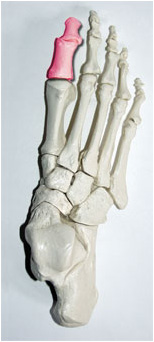Recogniziong that the four ground contact points that border our two longitudinal arches (one on each foot) are all we need to stand on, enables us to understand what role the other parts of the foot play in innate uprighting. These other parts function as a safety net.
Lateral Safety Net
It is very important to realize that the heel is rounded and does not lie flat on the ground. There is a pivot point toward the medial side that allows front-to-back and side-to-side play. There is good reason for this physiological reality. Our upright ancestors roamed a planet with very uneven terrain. Without the flexibility provided by our rounded heel -- and the many joints between the small foot bones in front of the talus -- the lower leg bones around the ankle would be a lot more susceptible to fracture. We especially needed protection against a lateral topple (a medial topple is not of concern, the other foot is there). When we hit this bump in the road, our lateral descent alerts our brain (through changes in ear and eye receptors) that compensatory muscle action is required.
